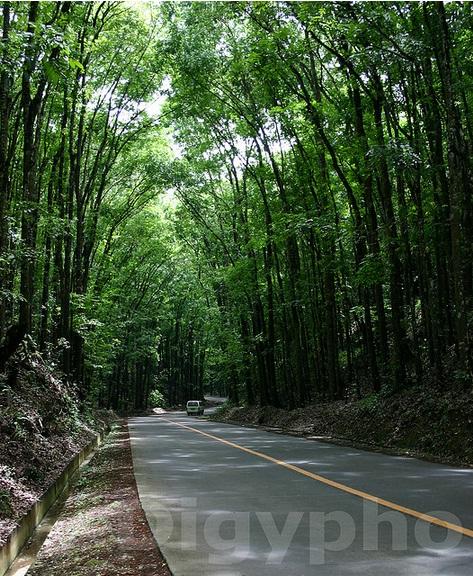
Bohol Man-made Forest (Mahogany Trees)
The Philippines has been blessed with some of the most biologically diverse as well as the most beautiful forests anywhere on the planet. These forests, either natural or man-made, have served many functions for people, and it is only now that most have become aware of the inherent importance of the forests and why our existence may ultimately be dependent on the survival of these wonders of nature.
The Bohol Forest
The Bohol Man-Made Forest is a mainly mahogany forest covering a two-kilometer stretch of densely planted mahogany trees. it lies on the border of Loboc and Bilar towns. Before and after you reach the man-made forest, there are also naturally grown forests of Loboc and Bilar which presents a thick kaleidoscope of colors of different shades of green and brown foliage, as well as an amazing variety of trees and giant ferns lining the road.
Palawan Mangrove Forest
One may get to know more about ecology by visiting the Palawan Mangrove Forest, which can be found in Sabang, Palawan, Philippines. One can only move about this forest by boats particularly suited for travel and navigation around the streams in between clumps of trees and vegetation. it is home to several varieties of Palawan Mangrove trees and different bird species. Riding a paddle boat up and down the river amidst hundred-year-old mangrove trees is definitely an enchanting and memorable experience. Mangroves are integral to the ecology of marine life as it prevents erosion by accumulating the residue from the rivers that the flow to the water which may affect the fish and other marine life.
Visitors are also asked to contribute to the forest by planting mangrove seedlings in a specific area to help make the forest proliferate.
Luzon Montane Rainforests
Luzon Montane Rain Forests encompasses the high elevations of numerous mountain ranges including the Northern and Southern Sierra Madre, which parallels the northeastern coastline of Luzon. Luzon is situated in the western Pacific Ocean. It is the biggest island in the Philippines and lies at the northern end of the island group. The montane forests are very precious for the wide range of endemic species. They prevent soil erosion and protect the good quality of water. This forest is one of the organically least well-known as ecoregions in the Philippines. Luzon has developed many exceptional species of plants and animals as outcome of its long-standing isolation from other landmasses. The montane forests of this ecoregion begin at about 1,000 m and are characterized by the appearance of oak and laurel species. Tree branches appear to be many times thicker than they really are because the moss covering the branch is so thick. Tree height may be only a few meters, and plants that are not typically epiphytes become aerial because of the thick moisture and abundant organic material on and around trees here.
The Higaonon Forest of Mindanao
The Higaonon Forest of Mindanao is 500,000 Hectares (1million acres) covering 5 provinces (Lanao Del Norte, Bukidnon, Misamis Oriental, Agusan Del Norte and Agusan Del Sur) and home to a number of endangered, including the largest eagle in the world, the Monkey-Eating Eagle.
Since 1954 multinational companies and illegal loggers have logged the forest until now only 500,000 Hectares of virgin rain forest remain a quarter of its unique size.
Specifically, the forest is a critical watershed area for most of Mindanao, including the provinces mentioned above without this forest there would be further widespread environmental degradation, threatening the existence and the livelihood of the people.
As do rainforests around the planet, it works like a huge sponge, soaking up the water and slowly distributing it down the mountains, thereby stopping erosion.
Virgin Forest in Camiguin Island
The island-province of Camiguin is a pear-shaped volcanic island in the northern tip of Mindanao. It is approximately 90 kilometers north of the City of Cagayan de Oro. It is bounded to the north by Bohol Sea, to the west by Macajalar Bay, to the southeast by Gingoog Bay and to the east by Butuan Bay.
Camiguin is the smallest province in Northern Mindanao, with its land area pegged at 29,187 hectares. It is composed of five towns, namely, Mambajao – the capital town, Mahinog, Guinsiliban, Sagay and Catarman. The island plays host to seven volcanoes, including the still-active Mount Hibok-Hibok. According to the National Statistics Office, Camiguin has a total population of 74,232 persons, making the province the second smallest in the Philippines in terms of population.
Among the Province's major products are coconut, cassava, banana, camote, palay, corn, fruits, coffee and vegetables. Camiguin's volcanic soil has proved to be a fertile ground for planting various crops. At present, the Provincial government is looking into an agricultural program that would increase the cultivation of fruit trees and vegetables in Camiguin. The Province is also among the best abaca fiber producers in the country. Camiguin is proud of its natural resources, which include sulfur deposits, geothermal energy, agricultural lands and fishing grounds.
The Camiguin culture is a mixture of both Boholano and Cebuano culture. It is very colorful and creative. The people are deeply religious, hospitable and friendly. Cebuano is the major dialect in the Province. However, in the towns of Sagay and Guinsiliban, where most of the indigenous tribes reside, the Kinamiguin dialect is still spoken. Kinamiguin is derived from the Manobo dialect with some mixture of Boholano.
Mindoro Rain Forest
Mindoro Rain Forest is located between the huge islands of Luzon and Palawan. This forest is isolated throughout the Pleistocene and retains its own unique character, together with the endemic water buffalo species that are common in this forest, the tamaraw, Philippine deer, pig and 42 indigenous mammal species is here. Its climate is tropical wet.
- http://wiki.answers.com/Q/What_are_the_names_of_the_forests_here_in_the_Philippines
- http://www.bohol-philippines.com/mahogany-man-made-forest.html
- http://www.flickr.com/photos/michaelcabrales/5489549942/
- http://www.localphilippines.com/attractions/2011/bohol-forest
- http://www.kriyayoga.com/philippines/mindoro/puerto_galera/tropical_sceneries_nature_photos/scenery_nature_photos.html
- http://www.eoearth.org/article/Mindoro_rain_forests
- http://saggi-space.blogspot.com/2012/03/deeper-into-palawans-mangrove-forest.html
- http://www.flickr.com/photos/poieef/4597298332/
- http://caaltd.org/Rainforest/Philippines/LuzonRainforests.aspx
- http://www.eoearth.org/article/Luzon_rain_forests
- http://www.unahi.org/higaonon-forest.htm
- http://www.flickr.com/photos/31945172@N06/3261671441/










